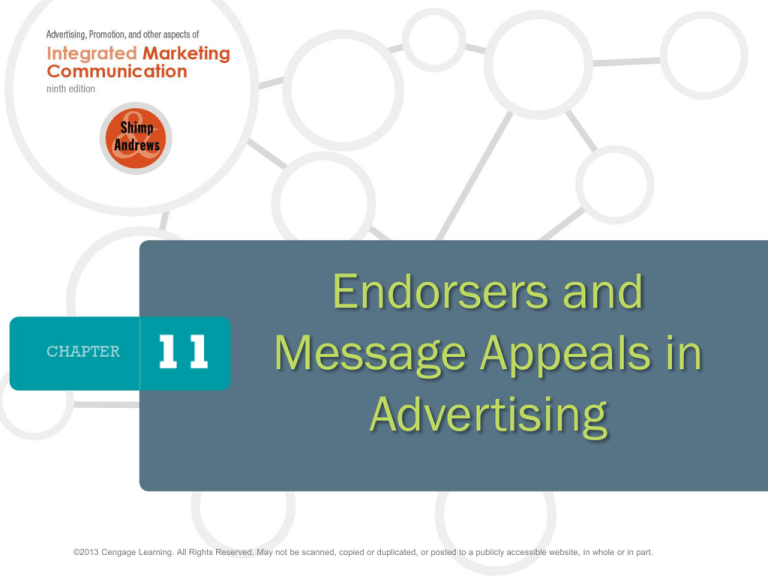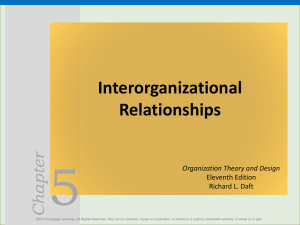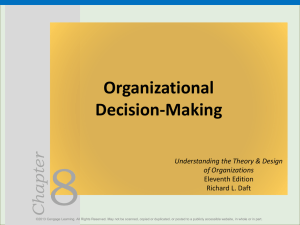
1
Endorsers and
Message Appeals in
Advertising
©2013 Cengage Learning. All Rights Reserved. May not be scanned, copied or duplicated, or posted to a publicly accessible website, in whole or in part.
Chapter Objectives
After reading this chapter you should be able to:
1. Describe the role of endorsers in advertising.
2. Explain the requirements for an effective endorser.
3. Appreciate the factors that enter into the endorserselection decision.
4. Discuss the role of Q-Scores in selecting celebrity
endorsers.
5. Describe the role of humor in advertising.
6. Explain the logic underlying the use of appeals to
fear in advertising.
©2013 Cengage Learning. All Rights Reserved. May not be scanned, copied or duplicated, or posted to a publicly accessible website, in whole or in part.
2
Chapter Objectives (cont’d)
7. Understand the nature of appeals to guilt in
advertising.
8. Discuss the role of sex appeals, including the
downside of such usage.
9. Explain the meaning of subliminal messages and
symbolic embeds.
10. Appreciate the role of music in advertising.
11. Understand the function of comparative advertising
and the considerations that influence the use of this
form of advertising.
©2013 Cengage Learning. All Rights Reserved. May not be scanned, copied or duplicated, or posted to a publicly accessible website, in whole or in part.
3
The Use of Humor and Comparisons in
Advertising: PC Guy versus Mac
©2013 Cengage Learning. All Rights Reserved. May not be scanned, copied or duplicated, or posted to a publicly accessible website, in whole or in part.
4
The Role of Endorsers in Advertising: Despite Troubles,
Tiger Continues to be Near the Top of Endorser Income
©2013 Cengage Learning. All Rights Reserved. May not be scanned, copied or duplicated, or posted to a publicly accessible website, in whole or in part.
5
Celebrity Endorsers
Examples of top celebrity endorsers today?
Advertisers are willing to pay large salaries to
celebrities who are liked and respected by target
audiences and who will favorably influence
consumers’ attitudes and behavior toward the endorsed
products
Any problems with the use of celebrity endorsers?
©2013 Cengage Learning. All Rights Reserved. May not be scanned, copied or duplicated, or posted to a publicly accessible website, in whole or in part.
6
Top Endorsement Incomes of American
Athletes
©2013 Cengage Learning. All Rights Reserved. May not be scanned, copied or duplicated, or posted to a publicly accessible website, in whole or in part.
7
The Role of Q-Rating (Q-Scores)
Q = (popularity/familiarity) x 100
number of people who describe the source
Q=
as “one of their favorites”
x 100
number of people who know of the source
©2013 Cengage Learning. All Rights Reserved. May not be scanned, copied or duplicated, or posted to a publicly accessible website, in whole or in part.
8
Typical-Person Endorsements
• Show regular people using or endorsing
products
• Avoid the backlash from using “beautiful
people” who may be resented
• Real personal experience of the benefits of the
particular brand grants a degree of credibility
• It is more effective to use multiple people
rather than a single individual
©2013 Cengage Learning. All Rights Reserved. May not be scanned, copied or duplicated, or posted to a publicly accessible website, in whole or in part.
9
Practical Considerations in the Selection of
Endorsers
1.
2.
3.
4.
5.
6.
7.
8.
Celebrity and Audience Match-up
Celebrity and Brand Match-up
Celebrity Credibility
Celebrity Attractiveness
Cost Considerations
Working Ease and Difficulty Factor
Saturation Factor
Trouble Factor
©2013 Cengage Learning. All Rights Reserved. May not be scanned, copied or duplicated, or posted to a publicly accessible website, in whole or in part.
10
“Success Factors for Athlete Endorsers”
• Attention getters
• Basketball, tennis, golf athletes are easier
• Large market exposure needed
• Good rapport with media
• Charisma, honesty
• Someone who is known by everyone –
not just in sports
©2013 Cengage Learning. All Rights Reserved. May not be scanned, copied or duplicated, or posted to a publicly accessible website, in whole or in part.
11
Kelman’s Source Attributes and Receiver
Processing Modes
©2013 Cengage Learning. All Rights Reserved. May not be scanned, copied or duplicated, or posted to a publicly accessible website, in whole or in part.
12
Figure 11.1: The Use of Humor in Advertising -E*Trade Baby
©2013 Cengage Learning. All Rights Reserved. May not be scanned, copied or duplicated, or posted to a publicly accessible website, in whole or in part.
13
The Role of Humor in Advertising:
Positive Effects
(“?” below = debate on effects)
•
•
•
•
•
•
Attracts attention
Enhances liking of ad and brand
Does not hurt comprehension (?)
Does not harm persuasion (?)
Does not harm source credibility (?)
Nature of product affects the appropriateness of using
humor (e.g., feeling-oriented; under low involvement)
©2013 Cengage Learning. All Rights Reserved. May not be scanned, copied or duplicated, or posted to a publicly accessible website, in whole or in part.
14
The Role of Humor in Advertising:
Negative Effects
• Effective only when consumers’ evaluations
of the advertised brand are already positive
• Effect of humor can differ due to differences
in audience and geographical characteristics
• Humorous message may be so distracting that
receivers ignore the message content
©2013 Cengage Learning. All Rights Reserved. May not be scanned, copied or duplicated, or posted to a publicly accessible website, in whole or in part.
15
Appeals to Consumer Fears
• Use of fear: physical or impending problems
• Appeals to fear can be effective as a means of
enhancing motivation (yet ethical issues)
• Can identify the negative consequences of:
• Not using the product
• Engaging in unsafe behavior (drinking and driving)
• Can take the forms of either
• social disapproval or physical danger
©2013 Cengage Learning. All Rights Reserved. May not be scanned, copied or duplicated, or posted to a publicly accessible website, in whole or in part.
16
Appeals to Consumer Fears
Fear-Appeal Logic
Stimulate audience
involvement with
a message
Social Disapproval
(Not using the
advertised brand)
Appropriate Intensity
of Threat Level
Consumers’ Motivation
to Avoid Negative
Consequences
Promote
acceptance of
message arguments
Physical Danger
(Engaging in
unsafe behavior)
Scarcity:
Psychological Reactance
(Fear of losing out)
©2013 Cengage Learning. All Rights Reserved. May not be scanned, copied or duplicated, or posted to a publicly accessible website, in whole or in part.
17
Inverted-U Hypothesis: Appropriate Fear
Intensity
Degree of
Persuasive
Effectiveness
(Note: this is an incomplete explanation)
Low
Moderate
High
Level of Fear Intensity
©2013 Cengage Learning. All Rights Reserved. May not be scanned, copied or duplicated, or posted to a publicly accessible website, in whole or in part.
18
Parallel Response Model
(Leventhal 1970)
Fear appeal with solution danger cues danger control adaptive action
(e.g., change behavior)
Fear appeal without solution fear cues fear control emotional response
(e.g., anxiety)
What two factors are needed for fear appeals to be effective?
©2013 Cengage Learning. All Rights Reserved. May not be scanned, copied or duplicated, or posted to a publicly accessible website, in whole or in part.
19
For Fear Appeals to be effective…
1. Appropriate level of threat given the
involvement of the target market
2. Need a prominent solution (e.g., your
brand or service) for the fear created
©2013 Cengage Learning. All Rights Reserved. May not be scanned, copied or duplicated, or posted to a publicly accessible website, in whole or in part.
20
The Functions of Music in Advertising
• Functions of Music in Advertising:
•
•
•
•
Attracts attention
Promotes positive mood
Increase receptivity of message
Communicates meanings
• Classical conditioning and tempo
research on music
©2013 Cengage Learning. All Rights Reserved. May not be scanned, copied or duplicated, or posted to a publicly accessible website, in whole or in part.
21
Distraction from Message Content
• Attractive sources, background scenery,
colors, music
• Arguments in favor of distraction: Reduces
counterarguments, positive emotions,
conditioning
• Arguments against distraction: Why
intentionally try to distract when there are
thousands of other distractions in processing
of ads?
©2013 Cengage Learning. All Rights Reserved. May not be scanned, copied or duplicated, or posted to a publicly accessible website, in whole or in part.
22
The Use of Sex Appeals in Advertising
• Elicits attention
• Enhances recall?
• Positive affect?
• Cultural issues
©2013 Cengage Learning. All Rights Reserved. May not be scanned, copied or duplicated, or posted to a publicly accessible website, in whole or in part.
23
Subliminal Messages and Symbolic Embeds
Subliminal
Refers to the presentation of stimuli at a rate
or level that is below the conscious threshold
of awareness
©2013 Cengage Learning. All Rights Reserved. May not be scanned, copied or duplicated, or posted to a publicly accessible website, in whole or in part.
24
A Cautious Challenge
• Three forms of subliminal stimulation:
• Visual stimulation using a tachistoscope
• Accelerated speech in auditory messages
• Embedding of hidden symbols
• Any evidence of support?
• Subliminal perception
• Link between subliminal advertising and behavior?
• See Timothy Moore (Journal of Marketing 1982),
“Subliminal Advertising: What You See is What
You Get”
©2013 Cengage Learning. All Rights Reserved. May not be scanned, copied or duplicated, or posted to a publicly accessible website, in whole or in part.
25
Message Sidedness: Generalizations
Use a 2-sided message if ...
1. The audience does not already agree with the
topic (brand, ad message)
2. Counterarguments are anticipated
3. The audience uses the competitor’s brand
4. The audience is better educated
©2013 Cengage Learning. All Rights Reserved. May not be scanned, copied or duplicated, or posted to a publicly accessible website, in whole or in part.
26
Figure 11.2: Illustration of a Direct
Comparative Advertisement
©2013 Cengage Learning. All Rights Reserved. May not be scanned, copied or duplicated, or posted to a publicly accessible website, in whole or in part.
27
Figure 11.3: Illustration of an Indirect
Comparative Advertisement
©2013 Cengage Learning. All Rights Reserved. May not be scanned, copied or duplicated, or posted to a publicly accessible website, in whole or in part.
28
Considerations in the Use of Comparative
Advertising
• Use if the audience does not have a prior preference for the
comparative brand
• Use with low involvement purchases (weak evidence)
• Use with new brands that possess distinct advantages over
competition
• Use if claims are credible (test results, spokespersons, 2-sided
claims)
• Use if sales are static and non-comparative ads ineffective
(weak evidence)
• Use in print (versus broadcast) media
• Relative framing of questions on comparative ad effects is
important
©2013 Cengage Learning. All Rights Reserved. May not be scanned, copied or duplicated, or posted to a publicly accessible website, in whole or in part.
29
Presentation Order
Order
Where Claims Presented
When to Use
1. Anticlimax
beginning
low involvement
2. Pyramidal
middle
never
3. Climax
end
high involvement
Is this more important for audio or visual print ad information?
©2013 Cengage Learning. All Rights Reserved. May not be scanned, copied or duplicated, or posted to a publicly accessible website, in whole or in part.
30
When the Audience Should Be Able to Draw
Their Own Conclusions
1. When they feel they are being
manipulated or their intelligence is
being insulted
2. Under high personal (ego) involvement
©2013 Cengage Learning. All Rights Reserved. May not be scanned, copied or duplicated, or posted to a publicly accessible website, in whole or in part.
31







